Reader’s Guide
A Nation of Nations
- The author’s grandfather immigrated to the United States from Norway, following the trail of others in his family. In what ways was their immigration experience similar to the experience of people who came to the United States 100 years later, from other parts of the world? In what ways was it different? (Prologue, Chapters 1-4, 11)
- According to the author, when was the United States first characterized as an “exceptional” nation, and in what sense was it considered unique? (Prologue)
- In the 1950s, it was difficult from someone from Korea to get permission to immigrate to the United States. Why was Pong Suk able to do so when so many other Koreans could not? (Chapter 1)
- Think about the stories from Korea and Bolivia. What would you say the people who choose to move away from home have in common with each other? What distinguishes them from people who choose to stay put? (Chapters 1-4)
- Immigrants are often said to take jobs that native-born American workers don’t want. Do you see examples of that in the stories that the author shares in Part One of the book? (Chapters 1-4, 12, 13)
- Describe some of the hardships and discouraging situations experienced by the immigrants the author profiles. What obstacles do they have to overcome in order to adapt to life in America? (Chapters 2-6, 12-14)
- In some predominantly African-American neighborhoods, the sudden arrival of a large number of immigrant families resulted in conflict. What are some of the reasons for this phenomenon? (Chapter 6)
- J.E.B. Stuart H.S. during the years when many immigrants were arriving had some of the lowest average student achievement scores in Fairfax County, but minority and ESL students did better at Stuart than anywhere else in the county. How was this possible? What challenges did this dichotomy present for the school leadership? (Chapter 7)
- Anti-immigrant sentiment has a long history in American political culture. Who were the first immigrant groups to encounter hostility in the United States? What was said about them? What efforts were undertaken by immigration opponents to limit the influx of foreigners? (Chapter 8)
- In what ways is the current debate over immigration an echo of the debate in the early years of the twentieth century? What cultural concerns were raised about some of the nationalities represented in that big immigration wave? (Chapter 8)
- In what ways, if any, did the enactment of national origin quotas reflect racist attitudes? (Chapter 8)
- How did domestic political considerations in the 1960 and 1964 elections affect the immigration debate? (Chapter 10)
- Congress passed the 1965 Immigration Act at the same time it approved several rights laws. In what ways can the 1965 Act itself be seen as a civil rights law? (Chapters 8, 10)
- How did Cong. Michael Feighan change the original version of the immigration reform proposal, and how has that change affected the character of immigration to this day? (Chapter 10)
- The author writes, “None of the people involved in the 1965 reform of U.S. immigration policy understood what they were doing.” Explain that statement. (Chapter 11)
- Experts say immigration to the United States is driven both by “push” in the home country and “pull” factors here in America. What do you think these terms means? (Chapters 1-4, 11)
- How did the pattern of immigrant settlement in the post-65 years differ from the pattern seen in the early years of the 20th century? What were the reasons for this shift? (Chapter 11)
- The Princeton University sociologist Douglas Massey highlights two important ways the post-65 immigrant influx differed from earlier immigration flows. Please explain. (Chapter 11)
- What tensions between African Americans on one side and Latino and Asian immigrants on the other side became apparent as a result of the 1992 riots in Los Angeles? (Chapters 12-13)
- How and where did tensions between African Americans and immigrant groups play out in the Washington DC metropolitan area? (Chapters 12-13)
- It was in America, a predominantly Judeo-Christian nation, not in his native Libya, that Esam Omeish became committed to Islam. The experience actually endeared Omeish to America, strengthened his American identity, and contributed to his patriotism. In what ways do you think America can be a place where immigrants like Omeish deepen their attachment to their own religious traditions? (Chapters 14, 21)
- What challenges did the immigrant influx in Fairfax County present to local authorities in terms of governance, law enforcement, and schooling? (Chapters 15, 18)
- Korean immigrants in general are far more likely to be engaged in self-employment activities in general and operate dry cleaning shops and convenience stores in particular. Why is this? (Chapter 16)
- The modern organized movement to restrict immigration grew out of the environmental movement. What is the connection between these two causes? (Chapter 17)
- One issue raised by the influx of non-European immigrants in the post-1965 period was that the newcomers would not embrace America’s Anglo-Protestant culture and political values and thus not make good Americans. Was this implicitly a racist argument or not? (Chapter 17)
- How did the experience of Muslim Americans in Fairfax County change after 9-11? (Chapter 18)
- What did Álvaro Alarcón, Fasih Khan, and Ho-Kwon Chun have in common? (Chapter 19)
- What did Álvaro Alarcón learn were some of the key contributing factors in explaining some of the problems encountered by the immigrant youth he counseled? (Chapter 19)
- The Asian and Muslim and Hispanic communities in northern Virginia rallied around political candidates who came out of their own communities and largely voted Democratic. (Chapter 20)
- The national motto for the United States is E pluribus unum, normally translated as “Out of Many, One.” The liberal historian Arthur Schlesinger in 1994 wrote that the danger of excessive praise for diversity in the United States is that it “belittles unum and glorifies pluribus. What did he mean by that? Do you think it was a valid concern? If so, why? If not, why not? (Chapter 21)
- How and why has the immigrant influx since 1965 changed the U.S. political dynamic? One election consultant told the author that immigrants to the United States are “a constituency whose political alliances could shift dramatically over time.” What did he mean by that? (Chapter 20)
- The Keam/Seong family, the Alarcón family, the Omeish family, and Marta Quintanilla all had their own ideas of what America stood for. What do you think America represented to each of them? (Chapters 7, 12, 14, 16, 19-21)
A Nations of Nations: In the Media
A Nation of Nations
Tom discussed A Nation of Nations during an hourlong interview on the Diane Rehm Show on Tuesday, September 15. Listen to the interview online or read the transcript>
Tom’s op-ed in the Washington Post: “The Unintended Consequences of a 50-year-old U.S. Immigration Bill”
Tom’s Atlantic Online column: “The Immigration Act That Inadvertently Changed America”
“Backstory” feature on A Nation of Nations on Washington Week webcast with Gwen Ifill
Tom’s npr.org feature story: “In 1965, A Conservative Tried To Keep America White. His Plan Backfired”
Tom’s profiles of immigrant families on npr.org: “Influx Of Non-European Immigrants Defines America Today”
“How the 1965 Immigration Act Changed America” Simon & Schuster author interview
“The Great Immigration Debate” Simon & Schuster author interview
Image Gallery
Bacardi and the Long Fight for Cuba
Bacardi and the Long Fight for Cuba is a unique history of Cuba, captured in the life and times of the famous rum dynasty. In chronicling the saga of this remarkable family and the company that bears its name, Tom Gjelten describes the intersection of business and power, family and politics, community and exile. Click on an image to enlarge.
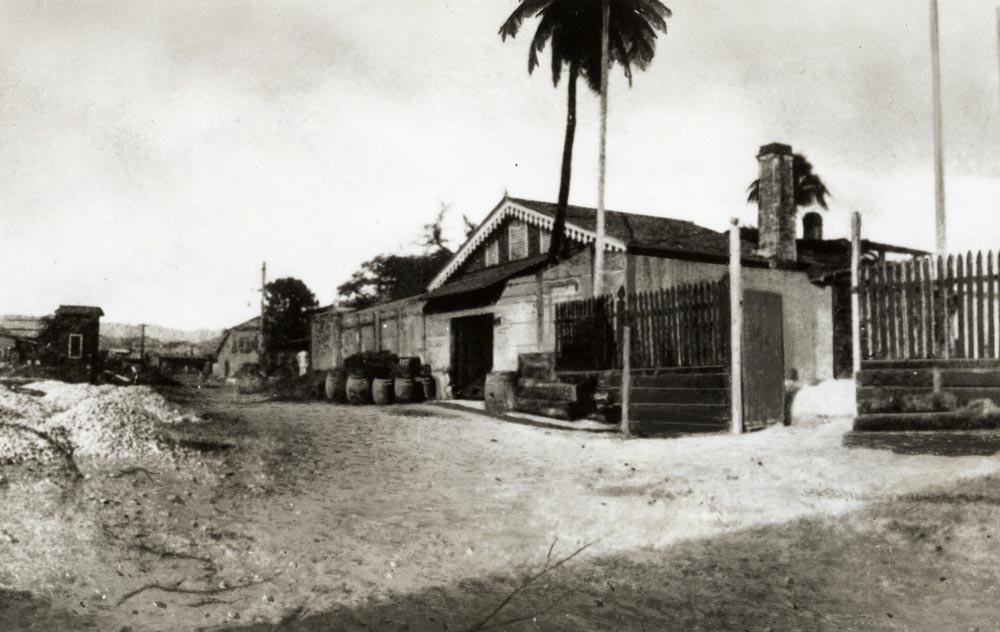
The palm tree in the front yard was planted by fourteen-year-old Facundo Bacardi, Jr., the son of the company founder, shortly after the distillery opened in 1862. 
Emilio Bacardi, son of Don Facundo Bacardi (the company founder), at about the age of thirty, a time when he was deeply involved in revolutionary plotting against Spanish colonial rule. 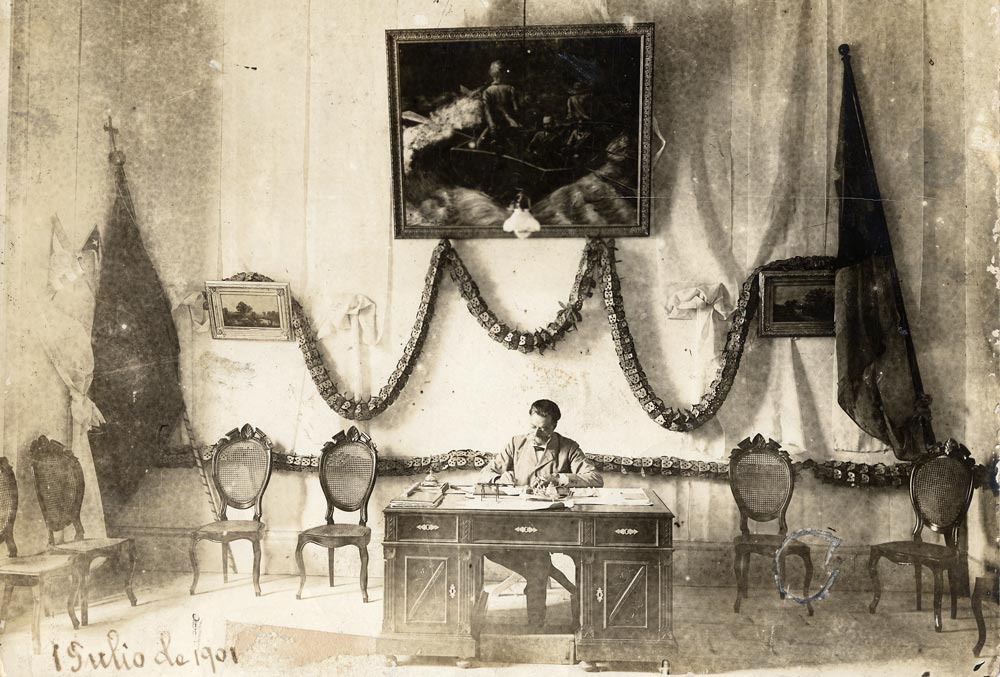
Emilio Bacardi was the first Cuban mayor of Santiago. Here he is at work in his city hall office in 1901. 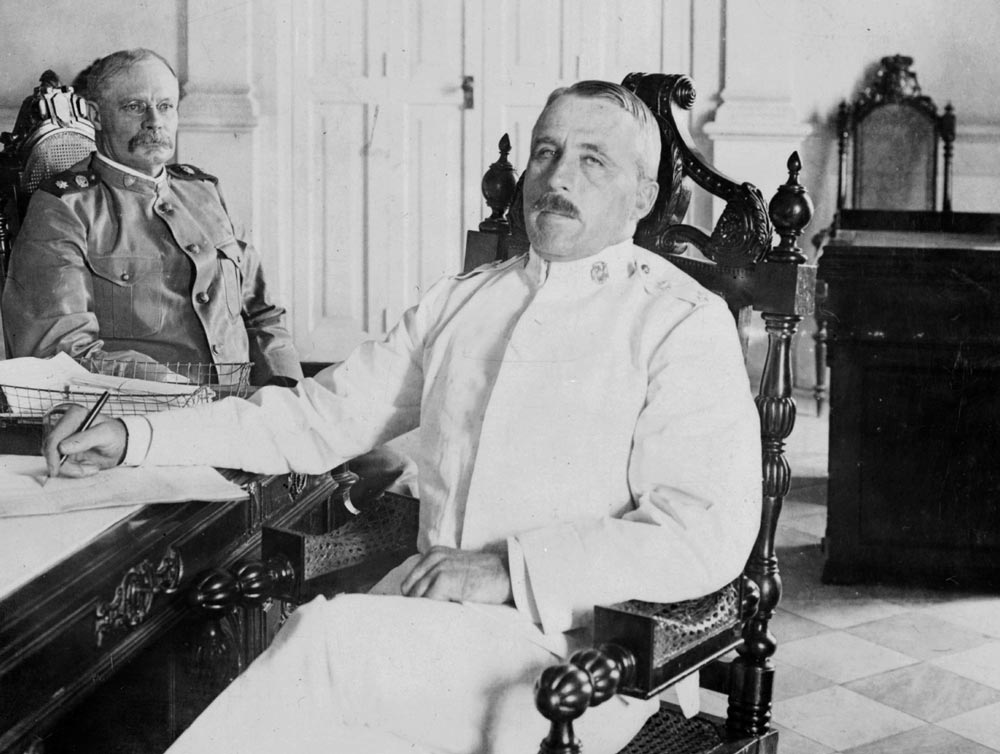
Emilio Bacardi respected Wood’s practical achievements but like other Cuban nationalists he was dismayed by Wood’s efforts to thwart Cuban independence. 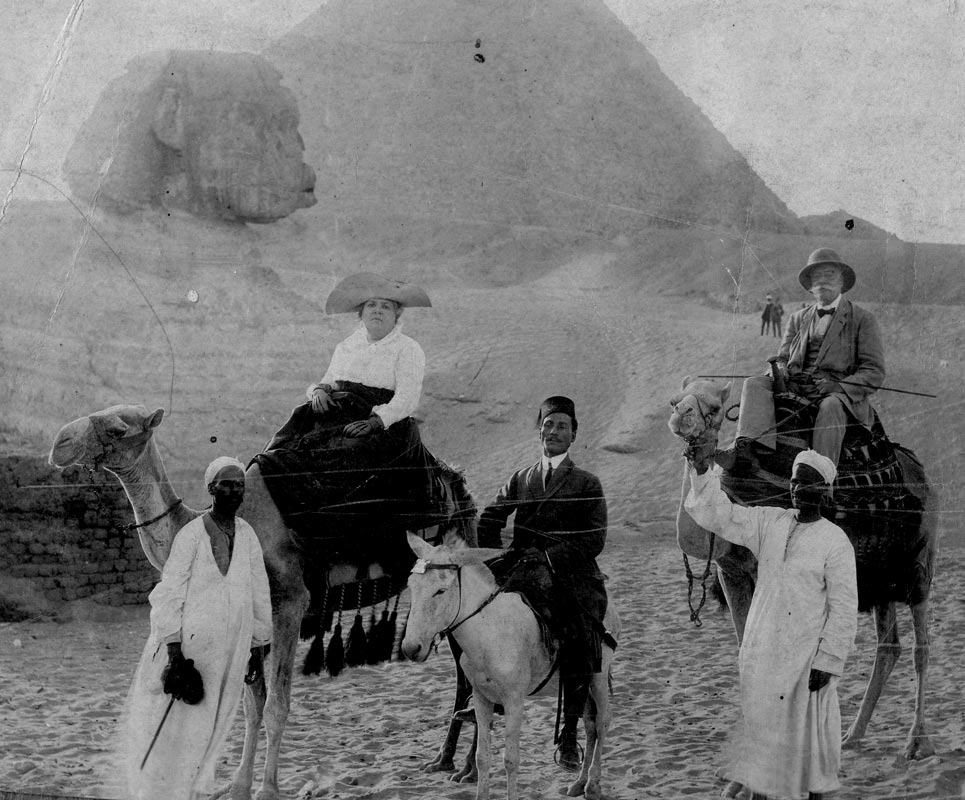
Emilio purchased a mummy and sent it back to display in Santiago at the museum he founded there. 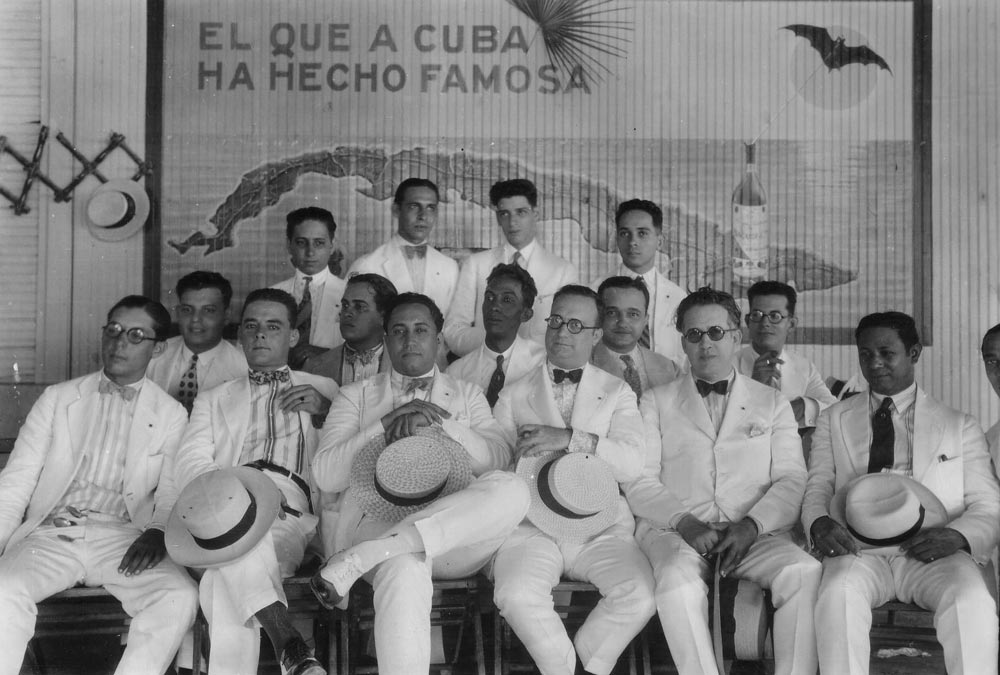
A group of Bacardi sales agents in the 1920s. The sign in the background features the slogan, “The One That Has Made Cuba Famous,” alongside the Bacardi bat. 
Mimín Bacardi, the daughter of Emilio and Elvira, with her bust of Cuba’s national hero, José Martí. A sculptress and suffragette, Mimín carried on the free-thinking attitudes of her parents. 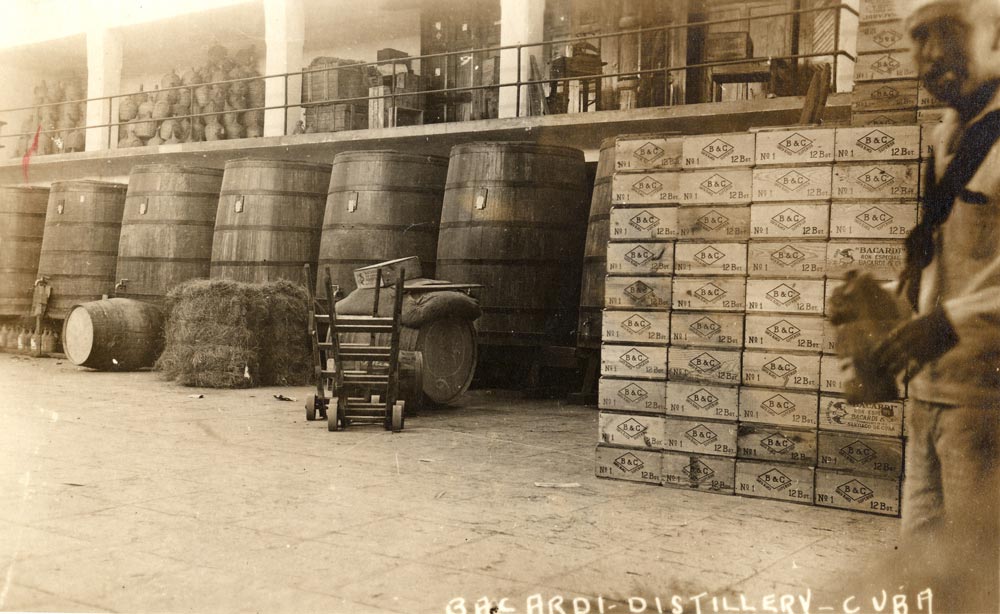
Bacardi rum was bottled and sold in wooden crates, visible at right, or in wicker-covered jugs, shown stacked on the mezzanine. 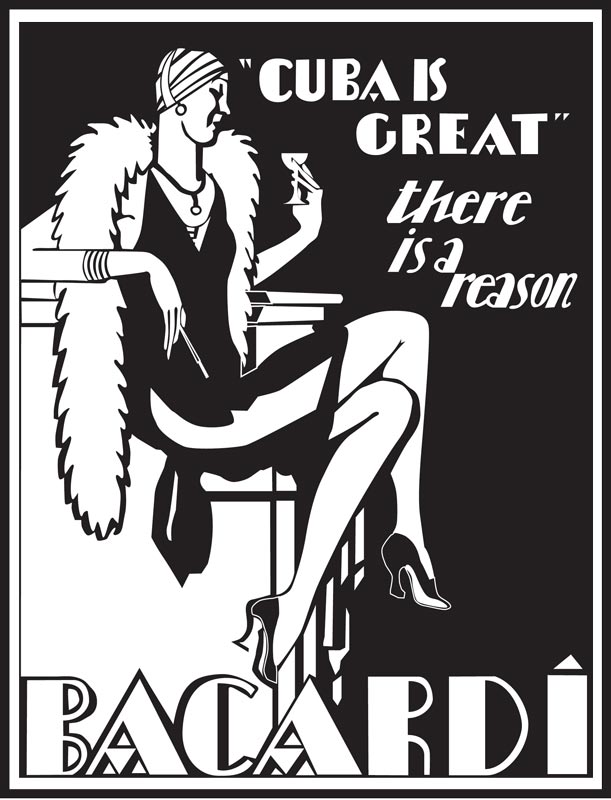
Company advertising in the 1920s and 1930s promoted the Bacardi association with Cuba, a favored vacation destination for U.S. tourists. 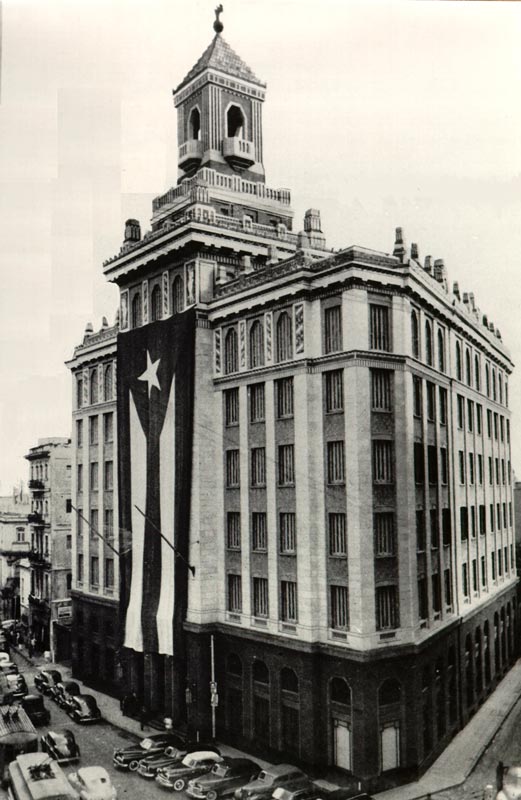
The art-deco Bacardi building in downtown Havana in 1952, the fiftieth anniversary of Cuban independence. 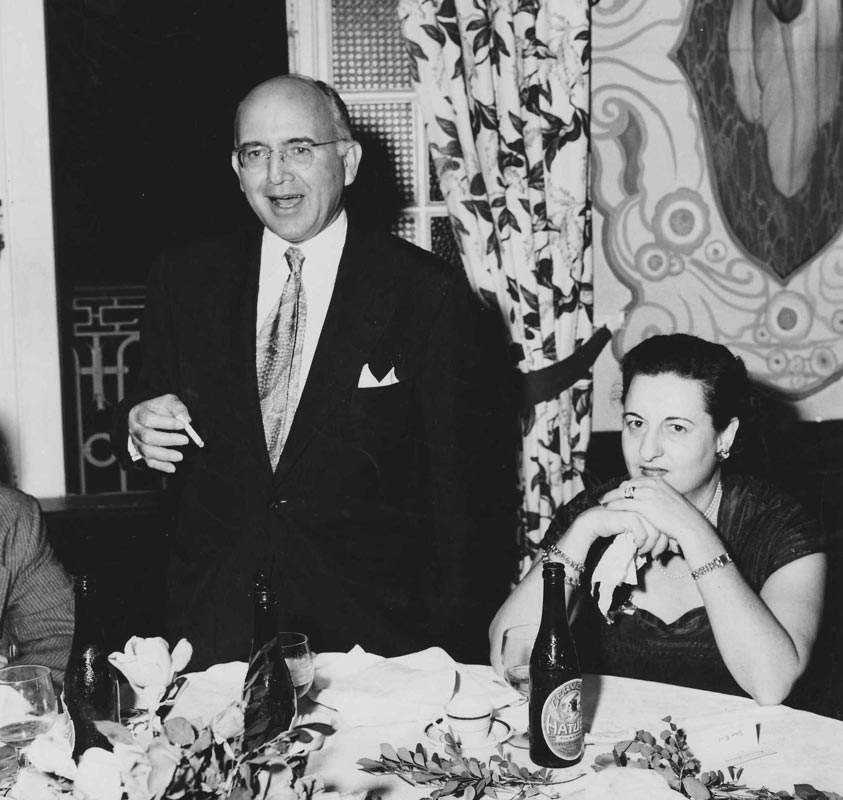
Bacardi president José “Pepín” Bosch, speaking to Bacardi sales agents in 1953. Bosch was married to the granddaughter of the company founder. Seated at right is Olga Covani Bacardi, the mother of future Bacardi chairman Manuel Jorge Cutillas. 
The Bacardi rum factory in Santiago as it appeared in the 1950s. The factory was built on the site of the original distillery, and the coconut palm is the same one planted by Facundo Bacardi, Jr. in 1862. 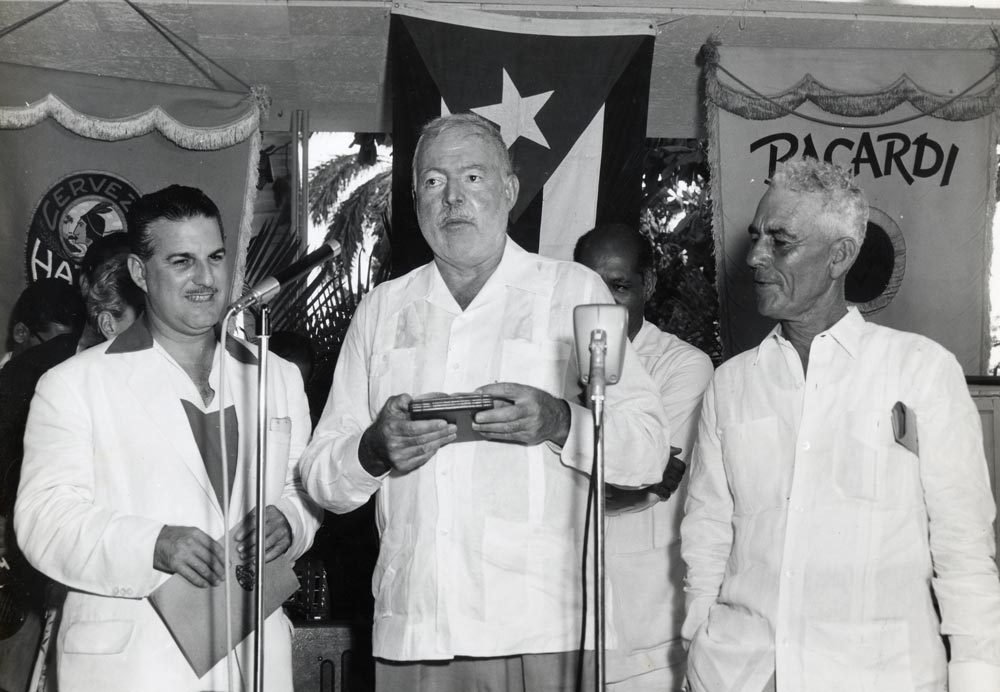
Ernest Hemingway was feted by Bacardi in 1956 in honor of his Nobel prize. Standing on Hemingway’s right is Fernando Campoamor, a noted Havana society columnist and Hemingway drinking pal. 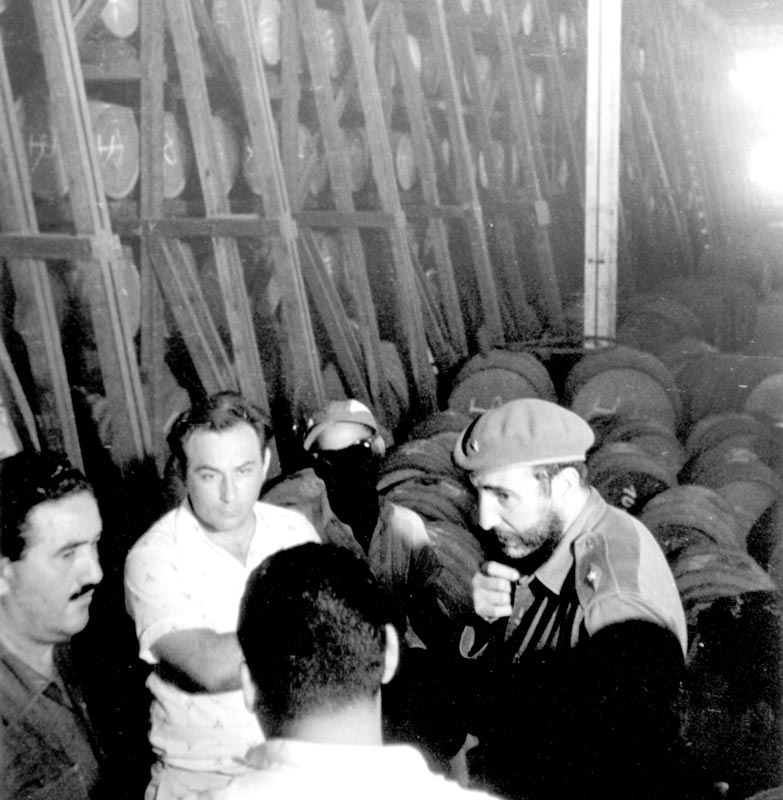
Fidel Castro, accompanied by local Communist Party officials, speaking to workers at the old Bacardi aging house in 1963, three years after Castro’s revolutionary government confiscated all Bacardi assets in Cuba. 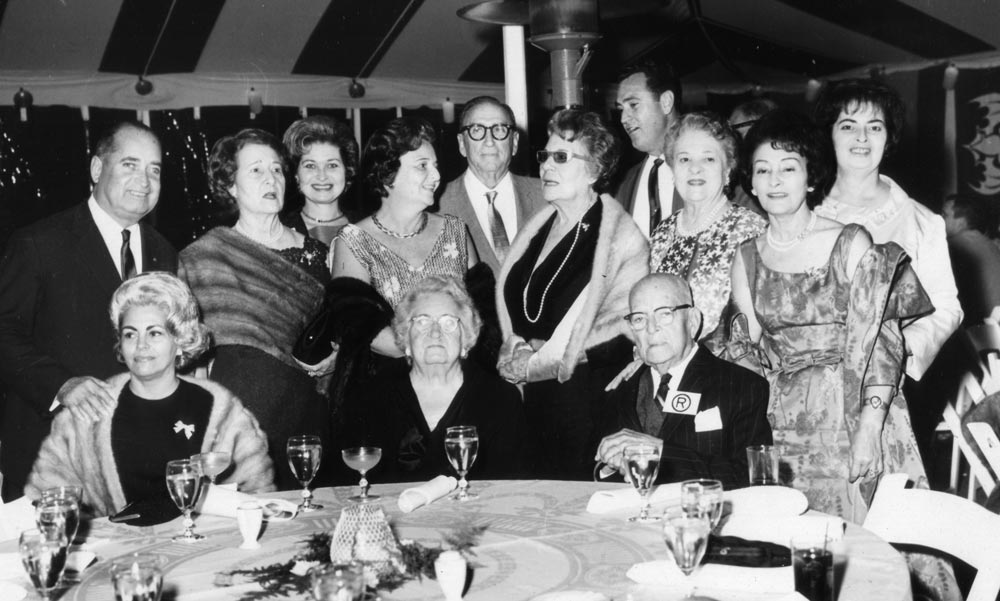
Eighty-nine-year-old “Colonel” Emilito Bacardi, the son of Emilio Bacardi and a veteran of Cuba’s independence war, is seated in front. 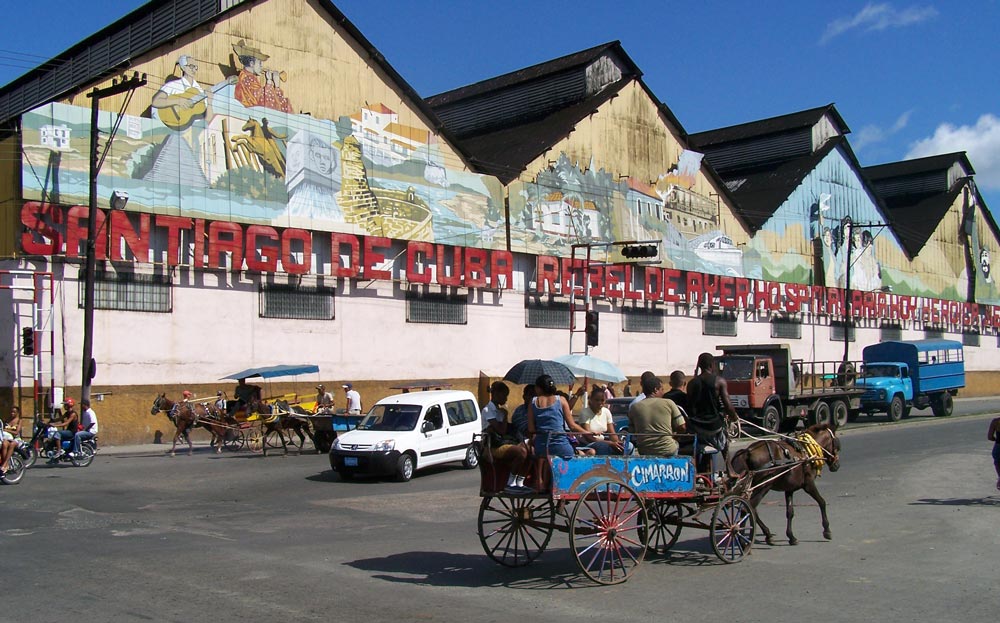
Horse-drawn taxis are still a familiar sight in Santiago. The slogan says, “Santiago de Cuba – Rebellious Yesterday, Welcoming Today, Heroic Forever.”
Reviews of Barcardi and the Long Fight for Cuba
Bacardi and the Long Fight for Cuba
“It’s hard to imagine that any (Cuban history) is as enjoyable as “Bacardi and the Long Fight for Cuba” by Tom Gjelten, a correspondent for National Public Radio. His book is as smooth and refreshing as a well-made daiquiri.”
–Barry Gewen, New York Times (read the entire NY Times review)
“A gripping saga that tells us just as much about human nature and the struggle between power and freedom as it does about Bacardi’s transformation from a fledgling business into the world’s top family-owned distiller.”
–Alvaro Vargas Llosa, The Wall Street Journal (read the entire Wall Street Journal review)
“A thoughtful, thorough piece of reporting. Tom Gjelten subtly and skillfully details the saga of the Bacardi family. You may never look at a mojito or a daiquiri quite the same way.”
–Peter M. Gianotti, Newsday (New York)
“With its fabulous triumphs and poignant defeats, this stirring tale of rum, money, and revolutions has all the markings of a great epic movie.”
–Richard Feinberg, Foreign Affairs (read the entire Foreign Affairs review)
“Absorbing history, at once a colorful family saga and a carefully researched corrective to caricatures of decadent pre-revolutionary Cuba.”
–Linda Robinson, The Washington Post (read the entire review) (Listen to the Washington Post Book World podcast interview with Tom Gjelten)
“Mr. Gjelten masterfully illuminates the biography of a cause personified by a proud family that pioneered a major business and shaped the recent past of Cuba, a neighbor whose still uncertain future will almost certainly affect America and the rest of the Western Hemisphere.”
–Harry Hurt III, New York Times Business Section (read the entire NY Times review)
“With thorough reporting and an eye for rich, often quirky detail, veteran National Public Radio correspondent Tom Gjelten traces the story of the Bacardi family, whose product helped shape Cuba’s soul until Fidel Castro nationalized its company’s facilities in 1960.”
–Will Weissert, The Chicago Tribune (read the entire review)
“Exhaustively researched, succeeds in painting a vivid portrait of the company’s early, scrappy years and its prominent role in the fight against Spanish rule. Gjelten provides a fascinating look at how the company built itself into the multinational giant it has become.”
–Randy Kennedy, New York Times Sunday Book Review (read the entire Sunday Book Review review)
“National Public Radio correspondent Tom Gjelten writes an appealingly smooth and colorful history – thorough and open-minded.”
–Peter Lewis, San Francisco Chronicle (read the entire SF Chronicle review)
“Gjelten has managed to capture in a single book almost all that one needs to know of Cuban history. His exhaustive reporting allowed him to delve deeply into the Cuban character and soul and reach conclusions that many Cubans will not like to hear, but which are nevertheless true.”
–Mirta Ojito, CJR (Columbia Journalism Review) (read the entire CJR review)
“A thoroughly researched and lively history of the family-owned drinks business, currently the third largest liquor producer in the world.”
–Christopher Silvester, Spectator Business (London)
“Gjelten leaves nothing unrecorded in his objective, warts and all, history of an unusual company, illustrating Cuban history without the canonizations by leftist apologists for Fidel and the demonizations by conservative Cuban exiles and their friends.”
–Ian Williams, World Policy Blog
“Tom Gjelten traces the history of the Bacardi family, their business, and their involvement in Cuban history with consummate skill. This is a first-rate distillation, at once illuminating and entrancing; a sweeping narrative that rivals the best of historical novels. This book will definitely enhance the buzz in every Daiquiri and Mojito, and give added meaning to every Cuba Libre served anywhere in the world”
—Carlos Eire, author of Waiting for Snow in Havana, winner of the National Book Award
“With a novelist’s sense of drama and a historian’s understanding of the social forces that shape our lives, Tom Gjelten has captured vividly — through the chronicle of a powerful family’s fortunes — one of the great political dramas of our time.”
–Ronald Steel, author of Walter Lippmann and the American Century
“Contained within family genealogy are often found profound insights into the history of an entire people. The Bacardís represent one such family. Gjelten has fashioned a splendid prism through which to cast new light on the human dimensions of the Cuban past. The epochal transitions of Cuban national formation are experienced through successive generations of Bacardís, revealing the complex ways that a people are overtaken by the forces of their own creation. Anyone with an interest in Cuban history–and a fondness for Cuban rum–will find the Bacardí family history irresistible.”
–Louis A. Perez, Jr., J. Carlyle Sitterson Professor of History, University of North Carolina at Chapel Hill
“Bacardi and the Long Fight for Cuba explores and illuminates the story of our nearest and largest Caribbean island neighbor in an utterly unique and fundamentally revealing way. Tom Gjelten has written a book that is a ‘must read’ for scholars, policy makers, and indeed anyone interested in the long, hard journey of Cuba — and for what will happen there next. A brilliant job!”
–Admiral Jim Stavridis, U.S. Navy, Commander, U.S. Southern Command
“A marvelous blend of biography and vivid history. This book will surely become essential reading to understanding both Cuba’s tragic past and the island’s post-Castro future. A stunning achievement from a versatile journalist.”
–Kai Bird, co-author of the Pulitzer-Prize winning biography, American Prometheus: The Triumph and Tragedy of J. Robert Oppenheimer
Bacardi and the Long Fight for Cuba Excerpt
Bacardi and the Long Fight for Cuba
A bottle of white Bacardi rum sold in the United States bears a small logo—mysteriously, a bat—and a label that says “Established 1862.” Just above the date are the words “PUERTO RICAN RUM.” There is no mention of Cuba.
The Bacardi distillery in San Juan is the largest in the world, but the Bacardis are not from Puerto Rico. This family company for nearly a century was Cuban, cubanísima in fact—Cuban to the nth degree. In the middle of the nineteenth century, Don Facundo Bacardi, the company founder and family patriarch, pioneered Cuban-style rum, lighter and drier than the rough spirit that preceded it. Bacardi rum became the drink of choice on the island just as Cuba was becoming a nation. Bacardi sons and daughters were famous for their patriotism, standing up first against Spanish tyranny and then, in the next century, against the island’s home-grown dictators. The family company played another supporting role as Cuba established its cultural identity, becoming the leading corporate patron of Cuban baseball and salsa music. Bacardi was Ernest Hemingway’s rum and the rum of the Cuban casino crowd. When Fidel Castro launched his uprising in the mountains outside Santiago de Cuba, their hometown, the Bacardis cheered him on. They did not abandon Castro so much as they were abandoned by him; they left Cuba only after the revolutionary government expropriated their rum business. Nearly fifty years later, the family name is still revered on the island, and the Bacardis are thinking about making rum there again.
Over many tellings, the Cuba story has hardened around a few stale themes—Havana in its debauchedheyday or Fidel Castro and his dour revolution—and it has lost much of its vitality and wholeness. This book originated in my search for a new narrative, with new Cuban characters and a plot that does justice to this island that produced the conga line and “Guantanamera” as well as Che Guevara’s five-year-plans. I have tried to give a nuanced view of the nation’s experience over the last century and a half. Cuban history was not preordained. There were choices made and paths not taken, and the men and women who were excluded and then exiled deserve to have their contributions recognized, if only to understand why so many became so angry. The Bacardi saga serves all these purposes.
For Cubans, patriotism began with the effort of poets and intellectuals to define the idea of a distinctly Cuban people out of the mix of Europeans, Africans, and natives who inhabited the island. Cuba then needed to free itself from three centuries of harsh Spanish rule and the dominating U.S. influence and become a sovereign, viable, and honorable country. Given the island’s cultural mix and plantation-based social structure, this fight necessarily incorporated a struggle for racial equality and economic justice, but it cannot be reduced to a story that ends inevitably with Fidel Castro’s socialist revolution. Other threads can guide us, such as that of the Bacardi family in the eastern city of Santiago de Cuba, the cradle of Cuban nationalism.
There was a time when no name in Santiago carried more prestige. Emilio Bacardi, the son of the patriarch Don Facundo, spent much of his adult life conspiring against Spanish rule and later served as Santiago’s first Cuban mayor. Emilio’s own son Emilito fought heroically in Cuba’s war for independence. But the Bacardis were also remembered in Santiago for their class and character. While they lived in elegant homes, rode in chauffeured carriages, and sent their children to exclusive private schools, they were also known as good Santiago citizens, generous and warm-hearted and fair. And they loved to party. The Bacardis probably contributed more than any other local family to Santiago’s reputation as a playful, joyous city with a vibrant night life. There was no festival in Santiago without Bacardi rum.
In Fidel Castro’s revised version of Cuban history, the era before his revolution was characterized mainly by decadence, and the country’s elites were corrupt. The Bacardis are barely mentioned, because their record of patriotism and integrity does not match the Castro stereotype. Their family business was widely recognized as among the best run enterprises in Cuba, and the company management was known for progressive policies and good labor relations. The Bacardi chairman in the 1950s, José “Pepín” Bosch (married to the founder’s granddaughter), served for a time as Cuba’s Finance Minister and broke precedent by pursuing wealthy tax cheats. When Castro went to Washington, D.C., shortly after taking power, Bosch was the one Cuban businessman he brought with him. Their break came after Castro embraced socialism; the Bacardi example had inconveniently demonstrated that there actually were capitalists who could play a responsible role in a democratic Cuba.
I do not, however, propose the Bacardis as would-be saviors of Cuba. The Bacardi story appeals to me in part simply because it contains so many critical but unfamiliar elements of the modern Cuban drama. At every stage of the nation’s development over the past century and a half, there is some Bacardi angle, some family member who is a key witness or behind-the-scenes player, or some Bacardi-related episode that epitomizes the historic moment. Countless families in eastern Cuba, for example, shared their Catalan and French roots, and by making and selling rum from Cuban molasses, the Bacardis pursued an enterprise tied directly to the country’s social and economic development. They came of age with the Cuban nation, and the epic tale of their lives and adventures across several generations features classic Cuban themes: revolution, romance, partying, and intrigue.
After Fidel Castro ordered the confiscation of their property and made clear they and others like them were no longer welcome in the new Cuba, the Bacardis left the island, rebuilding their rum enterprise through their operations in Puerto Rico and Mexico. In exile, they took on a new leadership role, this time as organizers and financiers of the anti-Castro opposition. Fidel lost an important ally when he pushed the Bacardis out, and he gained a determined adversary. The Bacardi-Castro conflict came to symbolize the division of the Cuban nation and the rival claims on the country’s history. In the first years of the twenty-first century, when the burning Cuban question was what would follow the Castro era, the Bacardis were once again players. Few products are so associated with Cuba as rum, and the family that made Cuban rum famous was anxious to reclaim a piece of that industry, one of the few on the island with promising growth prospects no matter who was in charge.
There is another story buried in this tale, too. Just as Bacardi history helps explain modern Cuba, the company’s Cuba connection helps us trace the evolution of a unique family firm. Bacardi Limited entered the twenty-first century as a genuine multinational, headquartered in Bermuda, with a product line that included whisky, gin, vermouth, vodka, and tequila, as well as rum. It nevertheless remained a private business wholly owned by a single family still feeling its Cuban identity. Its evolution reflects the strengths—and also the risks and challenges—of a closed, dynastic enterprise in an interconnected global economy. The company’s sense of heritage helped it survive after the loss of its Cuban headquarters, but there was inevitable tension between the old political values and the new focus on investment returns. On the eve of the post-Castro era, the Bacardi-Cuba connection set up a test that would reveal how the company had changed over the years: If it went back to Cuba—as it said it would—would it prove to be just another big, soulless corporation vying for a piece of the action, or would it return as the family company playing a patriotic role?
bacardi bat logoThe most distinctive element on a bottle of Bacardi rum is the peculiar icon at the top of the label: a black bat inscribed in a red circle. The bat’s wings are outstretched, and its head is turned slightly to one side, highlighting its big eyes and pointy ears. No marketing executive today would allow such a creepy image to identify a popular brand. But the Bacardi symbol dates from an era when bats were viewed more tenderly, and the story of its adoption reflects the company’s humble Cuban origins. Santiago was a small city full of merchants, slaves, and traders. Don Facundo’s home-made rum was occasionally sold in recycled olive oil tins that came with a picture of a bat on the side. As Bacardi rum gained in popularity, some customers in Santiago referred to it as el ron del murciélago, “the rum of the bat,” and the association took hold.
For good reason. The bat was a symbol of good fortune, and it figured prominently in the heraldry of Don Facundo’s native Catalonia. As creatures, bats exemplified the ideal of brotherhood, because they lived and flew together; they symbolized self-confidence, because they could fly in the dark without hitting anything; they stood for discretion, because they kept silent; and they represented faithfulness, because they always returned home.
A Nation of Nations: Prologue
A Nation of Nations
The family farm sat on the edge of a pristine glacial lake in Norway’s fjord country, in a sparsely settled district known as Årdal, which was therefore the family name. Behind the barn, a dirt trail led up a valley into the mountains. The hillsides were steep and rocky, but the soil was fertile and well watered by glacial runoff. In the summer, cattle and sheep grazed on the verdant slopes. The Årdal family named it Søgnhildtunet—Søgnhild’s Place—after one of the early Årdal women. The property had been in the family as far back as 1759, passing from father to firstborn son according to the ancient primogeniture law that guaranteed continued family ownership of Norway’s farmland.
By 1864, Søgnhildtunet should rightfully have passed to Johannes. But he was just twenty-two and restless, and the prospect of following the familiar path of his father, grandfather, and great-grandfather left little to his imagination. In Norway, he faced a predictable future, and not an easy one. For all its natural beauty, Søgnhildtunet would never be a farm that yielded abundance. The winter was long and dark and cold. To stay there would be to settle for the narrow nineteenth-century world of the Norwegian peasantry. His forefathers had no choice, but Johannes did.
The talk in Årdal in those days was of going to America, a country wide open to Norwegian immigrants. From towns on the west coast, ships were sailing daily to Bergen or Liverpool or other transatlantic embarkation points. For the equivalent of about thirty dollars, companies offered special “America” packages, covering steamship travel across the ocean plus rail transport into the U.S. interior. Large tracts of tillable land, so scarce in Norway, stood empty in Wisconsin and Minnesota and the Dakota Territory. Dreaming of new lives in a different land, Johannes and his twenty-year-old wife, Brite, said good-bye to their families and headed across the Atlantic.
With Johannes abandoning his claim, the farm in Årdal passed to the next oldest son, Ole. There were two other sons in the family, however—Samuel and a second Ole—and when they reached adulthood a few years later, they had no land of their own and nowhere to find work. Norway in the nineteenth century had one of the highest rates of population growth in Europe, but it still had a preindustrial agrarian economy that offered few employment opportunities. More than two thirds of the population lived in rural areas, the majority of them landless. The Årdal brothers knew what they needed to do, and in the spring of 1875, they sailed to Liverpool. From there, they booked passage to America on the Allan Steamship Line, a route favored in those years by tens of thousands of Norwegians.
In each decade from 1860 to 1910, the country lost about 5 percent (and sometimes more) of its population to emigration. Only Italy and Ireland lost proportionally more. The vast majority left rural Norway and made their way to the rural United States. The Norwegian American writer Ole Rölvaag called it “The Great Settling,” and in his novel Giants in the Earth he painted a vivid portrait of the Norwegian immigrants’ experience as they fanned across the upper Midwest. They traversed the plains in covered wagons, towed by oxen that would later be put to use plowing fields or hauling timber.The wagons were packed with the things they would need to start a frontier life—household utensils, farm implements, clothing, bedding.
Samuel and Ole made their way to western Minnesota, where their brother Johannes had homesteaded a decade earlier. By the time his younger brothers showed up in June of 1875, Johannes had an established farming operation, and he immediately put Samuel and Ole to work. After the harvest season, Samuel and Ole found work in the area as laborers, hiring out to whoever needed help. During the winter, when farmwork was scarce, they attended public school—grown men sitting alongside nine- and ten-year-olds—in order to learn English. Once they had saved enough money to buy some livestock and a wagon, Samuel and Ole moved on to look for land of their own. They headed first toward the Red River Valley in the northeast corner of Dakota Territory. It was a slow journey. The cattle they brought with them were constantly hungry and kept stopping to graze along the way. Nearing the Red River, they found the plain almost entirely flooded and had to wade through the water and muck. Mosquitoes tormented them.
Most of the land they crossed had already been settled, so they pressed on to the west, where there was still acreage free for the taking. The southern part of Dakota featured abundant grassland, but the Årdal brothers, having grown up among fjords and mountains, were not drawn to wide open spaces, so they stayed to the north. As they plodded on, they encountered fewer and fewer sod shacks, until at last they reached territory no one else had claimed. The land had not been surveyed yet, and Samuel and Ole could take it simply by driving stakes into the ground and declaring it theirs.
The terrain was somewhat reminiscent of rural Norway, but this was virgin land. Everything Samuel and Ole built, they built by hand. Most of the work they did, they did for the first time. Ingenuity and enterprise were key. For their first shelter, they turned their wagon box upside down and mounted it on four posts, laying the canvas over the top. Next, they built rudimentary log cabins. After stripping the logs, they stacked them one atop another, filling the spaces between with clay from the riverbed. The roof was made of bark and sod, laid carefully across pole rafters. In Norway, the farm life had been ritualized, consisting of chores done the same way, generation after generation. In America, the sod Samuel and Ole opened with their plows had never been broken before. The land had never been planted, the fields never fenced. The whole venture was exhilarating. This was the Norwegian immigrant experience that inspired Rölvaag: As Per Hansa lay there dreaming of the future it seemed to him that hidden springs of energy, hitherto unsuspected even by himself, were welling up in his heart. He felt as if his strength were inexhaustible.
Success in America for immigrants required looking ahead and focusing on what had been gained, not what was left behind. The Årdal brothers would never see Norway again. They had year-round farming responsibilities and soon were raising families. The “old country” was impossibly far away. Inevitably, the immigrant experience included periods of loneliness, especially acute there on the Great Plains. But Norwegians were known for their stoicism. Pious Lutherans and not given to frivolity, the brothers worked hard and skillfully and prospered in their new farming lives, cultivating wheat, oats, and potatoes. They dutifully came to see themselves as Americans, but it was not hard. No one marginalized them as newcomers, challenged their presence on the land, or questioned their loyalty, identity, or religion. With other local immigrants, they built schools and churches. As pioneers, they took that part of America as their own, and no one questioned their claim.
Back in Norway, the emigration continued. In 1883, Samuel and Ole’s sister Brita left with her husband, Tollef, and joined her brothers in North Dakota. In 1900, their nephew Nicolai followed, thirty-six years after his Uncle Johannes had blazed the trail. He had also lost the Søgnhildtunet inheritance to an older brother. Like the others, he headed to North Dakota and worked for his relatives, attending a one-room country school to learn English. But the farming life was not a good fit, and Nicolai opted for business school, eventually finding work at a bank in the town of Milton. There, he met and wed a young schoolteacher named Bessie, the daughter of an immigrant from England. Their marriage produced five children, among them my mother.
The country my ancestors chose as their new home had a political culture that grew largely from the pattern of its settlement. In Europe, the people came with the territory, but in America, the territory came first, and those arriving from other lands became American citizens by swearing allegiance to the new nation and the individualist ideology on which it was founded. “They must look forward to their posterity rather than backward to their ancestors,” John Quincy Adams said of the immigrants. By coming to America, they could assume a new national identity based on their adherence to a creed and a set of values.
To outsiders, the American character was shaped on the frontier, where rewards came in return for effort and enterprise. The French travel writer and historian Alexis de Tocqueville, having visited the United States in 1831, was struck by the egalitarianism of American life, which he largely attributed to the country being a “new and unbounded” place where people coming from foreign lands could start over, all on the same basis. It was a country “where the inhabitants arrived but as yesterday upon the soil which they now occupy, and brought neither customs nor traditions with them there.” As Adams had noted a decade earlier, the separate genealogies that had channeled people in the Old World into one or another future were irrelevant in America. Class differences mattered little, because the abundance of opportunity produced a degree of social mobility in America unmatched anywhere else in the world. Instead of deferring to authority, Americans learned to be self-reliant. “As no signs of incontestable greatness or superiority are perceived in anyone of them, they are constantly brought back to their own reason as the most obvious and proximate source of truth,” Tocqueville wrote. Comparing America to other countries he knew, he found it unique in almost every way. “The position of the Americans is quite exceptional,” he concluded.
Thus arose the American myth that would inspire people around the world desperate for a chance to prove themselves in a new land. “The bosom of America is open to receive not only the Opulent and respectable Stranger,” George Washington had famously declared, “but the oppressed and persecuted of all Nations and Religions, whom we shall welcome to a participation of all our rights and privileges, if by decency and propriety of conduct they appear to merit the enjoyment.” No country on the planet would be as associated ideologically with immigration as the United States. The foreigners who broke ties with their old countries, pursued new opportunities in this different land, and were willing to be judged on their own merits and achievement personified the model American. This was said to be the nation of new beginnings, where people could be defined, in the words of immigration historian Oscar Handlin, “not by virtue of common descent but rather of common destiny.”
The experience of my own Norwegian relatives matched the idealized version of the immigrant story. America was indeed the place where their ambitions were limited only by their own talents, will, and discipline. After becoming a bank officer, my grandfather Nicolai lost almost everything in the 1930s, but his faith in his adopted nation and his pride in what he had become were unbroken. To the very end of his life, he wore a white shirt and necktie seven days a week, every day of the year. It was not some carryover of an Old World custom; in Norway, he was raised on a farm. If anything, his dress served to highlight his break from his own rural background. On a return visit to Søgnhildtunet at the age of eighty-four, his relatives took a picture of him sitting on a hay rake behind a horse, dressed even there in a shirt and tie. It was as if to show he belonged at a desk in his North Dakota bank, not in a hay field in Norway.
For most of the world’s population, however, the American immigrant promise was hollow. In reality, it was limited to people of the same skin color as my Scandinavian ancestors. Despite George Washington’s lofty declaration, the first immigration law passed by Congress in 1790 offered U.S. citizenship only to “free white persons.” The foreigners who settled in the United States over the first two hundred years of its history were from Europe and almost nowhere else, except for those Africans who came as slaves or were born into slave families, and they had to struggle mightily to gain membership in the nation. Almost everyone else was limited by poverty or circumstance from moving to the United States, or they were barred under U.S. law from coming at all. Thousands of Chinese, almost entirely men, were admitted in the middle years of the nineteenth century, but only as contract laborers, and with the passage of the Chinese Exclusion Act in 1882, Chinese immigration was officially prohibited. The more people wanted to move to America, the more difficult it became to obtain American citizenship. Even those coming from southern and eastern Europe found they were unwelcome. The Harvard-trained lawyer Prescott Hall, cofounder of the influential Immigration Restriction League, posed the critical question in 1897: “Do we want this country to be peopled by British, German, and Scandinavian stock, historically free, energetic, progressive, or by Slav, Latin, and Asiatic races, historically downtrodden, atavistic, and stagnant?”
So much for the Tocquevillean idea that America’s immigrant history promoted an egalitarian and individualist political culture, supported creativity and enterprise, and produced this new nation where one’s ancestry did not matter. In the view of the immigration restrictionists, it was not the liberating and energizing experience of venturing across the ocean and into an unfamiliar environment that led my North Dakota forebears to prosper. Rather, they achieved what they did simply because they were Norwegian. That view was reflected in a 1924 law that allocated immigration slots on the basis of the candidates’ national origins and effectively excluded most Asians from citizenship.The thrust of the legislation was reinforced with the passage of the McCarran-Walter Act in 1952. Each of the Asian, African, and Middle Eastern countries was allocated barely a hundred immigrant visas per year, while Germany, the United Kingdom, and other countries of northern and western Europe each received thousands of reserved slots. The evident premise of U.S. immigration law was that the explanation for America’s success in the world actually lay in its European heritage, not in its history as a country shaped by enterprising newcomers.
It was only after 1965 that the United States unconditionally embraced its immigrant character, and it did so unintentionally. The 1965 amendments to existing law effectively ended the allocation of immigrant visas on the basis of national origin, putting applicants from around the world on a mostly equal basis. The reforms coincided with dramatic changes in the global order. In newly prospering Europe, economic and social pressures were no longer pushing people to seek new opportunities abroad. At the same time, the developing countries were experiencing population growth, rising aspirations, and heightened conflict. In those regions, more and more people wanted to leave, and improved communication and transportation—across the whole world and not just the Atlantic Ocean—facilitated their migration.
So they came, in far greater numbers than the legislators of 1965 had anticipated. In the next fifty years, the percentage of the U.S. population born outside the country tripled and shifted dramatically in composition, with immigrants arriving from Vietnam, Korea, India, Pakistan, Egypt, Mexico, Central America, Ethiopia, Nigeria, and many other places previously unrepresented. Their experiences were not so different from those of my Norwegian ancestors. They came because opportunities were lacking in their own countries, and they were attracted by what America offered. Like the immigrants of a century earlier, they took risks and were rewarded for their perseverance and initiative. The obstacles they faced, on the other hand, were bigger than anything their predecessors encountered. These new immigrants could not disappear easily into a white Euro-American society, no matter how hard they tried. Language barriers sometimes kept them isolated; even their ideas about God, family, and work could set them apart. Devout Muslims stood out in particular. In this alien environment, some immigrants would experience rejection and a disappointment that cut even deeper than the pain that drove them to leave home in the first place; others discovered that hard work and ambition could actually lead somewhere in this country.
The immigrant influx set up a belated test of America’s character and identity. Was its strength and resilience a result of its formation as “not merely a nation but a teeming nation of nations,” as Walt Whitman said? Or were its achievements actually due to its Anglo-Saxon heritage? That aspect of American society was fast diminishing in relative importance, replaced by unprecedented racial and ethnic diversity. The country had not yet dared to see whether it could live up to its motto, E pluribus unum, “Out of many, one” (an expression that referred originally to the thirteen colonies coming together as one state). At last, America could find out whether it was truly an exceptional nation and what it really meant to be American.
The story unfolded with particular drama in some communities, like one suburban county in northern Virginia that experienced a lifetime of change in a few short years, as immigrants arrived from all sides of the world, with experiences the local old-timers never could have imagined. Some were poor. Some came from professional families. All were enterprising, and together their lives represented the experience of a diversifying nation.
From A Nation of Nations by Tom Gjelten.
Reviews for A Nation of Nations
A Nation of Nations
“The 21st century will be defined by seismic global immigration, remapping human interaction to the core, and the United States will remain the model for other nations to emulate. Tom Gjelten understands why, not only because he is a byproduct of immigration, but because he has been in the trenches—the inner cities, the rural landscapes, the contested borders‑‑where America is reborn on a daily basis. In this probing exploration, he explains, lucidly and with compassion, the extent to which the motto e pluribus unum is the engine of progress.”
— Ilan Stavans, editor of Becoming Americans: Immigrants Tell Their Stories from Jamestown to Today
“Tom Gjelten sings of a new America that bravely invites newcomers. A Nation of Nations would have pleased Whitman himself for its generosity, spirit and hope. This book is both smart and moving.”
— Min Jin Lee, author of Free Food for Millionaires
“An incisive look at immigration, assimilation, and national identity. . . . A timely, well‑informed entry into a national debate.”
— Kirkus Reviews
“A compelling case for multiculturalism, coupled with assimilation to the U.S. political culture of democracy and individualism, as the new American exceptionalism… A timely, measured, and sympathetic account of changing U.S. demographics within the past several decades.”
“A Nation of Nations … builds through the accumulation of detail to a book of impressive heft. Gjelten excels as he documents the reality of each family. It is harder to say what this all means, but perhaps that is because we have not yet arrived at the answer. One has the sense, at the end of the book, that this experiment is still very much a work in progress.”
“In 1965 the percentage of immigrants in the United States was only 4.4%. Today, thanks in large part to the Immigration Act of 1965, it stands at 13%. This demographic shift has had profound effects, and in “A Nation of Nations,” National Public Radio correspondent Tom Gjelten brings these changes to life.”
“Gjelten has produced a compelling and informative account of the impact of the 1965 reforms, one that is indispensable reading at a time when anti-immigrant demagoguery has again found its way onto the main stage of political discourse.”
“With careful reporting and a storyteller’s feel for narrative, [Gjelten] reconstructs the grand deal-making that yielded the law President Lyndon Johnson signed on New York’s Liberty Island. He also goes deep into the lives of a half-dozen immigrant families in Fairfax County, Virginia, describing how they doggedly go about creating the better future they were seeking in the United States, even when the country makes nothing easy for them.”
Tom Gjelten
About
For nearly four decades, TOM GJELTEN was a correspondent for NPR News. He retired from the network in 2021, after reporting on national and international news from posts in Washington and around the world. He joined NPR in 1982, assigned to the labor and education beat. In 1986, Gjelten became one of NPR’s pioneer foreign correspondents, posted first in Latin America and then in Central Europe. In the years that followed, he covered the wars in Central America, social and political strife in South America, the first Gulf War, the wars in the former Yugoslavia, and the transitions to democracy in Eastern Europe and the former Soviet Union.
His reporting from Sarajevo from 1992 to 1994 was the basis for his book Sarajevo Daily: A City and Its Newspaper Under Siege (HarperCollins), praised by the New York Times as “a chilling portrayal of a city’s slow murder.” He is also the author of Professionalism in War Reporting: A Correspondent’s View (Carnegie Corporation) and a contributor to Crimes of War: What the Public Should Know (W. W. Norton).
After returning from his overseas assignments, Gjelten covered U.S. diplomacy and military affairs, first from the State Department and then from the Pentagon. He was reporting live from the Pentagon at the moment it was hit on September 11, 2001, and he was NPR’s lead Pentagon reporter during the early war in Afghanistan and the invasion of Iraq. Gjelten has also reported extensively from Cuba in recent years. His 2008 book, Bacardi and the Long Fight for Cuba: The Biography of a Cause (Viking), is a unique history of modern Cuba, told through the life and times of the Bacardi rum family. The New York Times selected it as a “Notable Nonfiction Book,” and the Washington Post, Kansas City Star, and San Francisco Chronicle all listed it among their “Best Books of 2008.” His latest book, A Nation of Nations: A Great American Immigration Story (Simon & Schuster), recounts the impact on America of the 1965 Immigration Act, which officially opened the country’s doors to immigrants of color. In his final assignment, Gjelten was NPR’s religion and belief correspondent, reporting on such issues as the changing religious landscape in America, the formation of personal identity, the role of religion in politics, and social and cultural conflict arising from religious differences.
During his years at NPR, Gjelten was honored with two Overseas Press Club Awards, a George Polk Award, a Robert F. Kennedy Journalism Award, and a National Headliner Award. He is a member of the Council on Foreign Relations. A graduate of the University of Minnesota, he began his professional career as a public school teacher and freelance writer.
Anwar Omeish
A Nation of Nations, Immigration
Esam and Badria Omeish and their daughters Abrar and Anwar have all been leaders in their communities in Northern Virginia. Esam, who came to America at the age of fifteen, was active in the Muslim Students Association at both the local and national levels.
His wife Badria, a molecular biologist, is a college teacher. Abrar and Anwar excelled in their public high schools and went on to study at Yale and Harvard, respectively.
The 1965 Immigration Act brought new opportunities for people from predominantly Muslim countries to move to the United States, and Muslims are now one of the fastest growing immigrant groups in the country. Their integration in American society has exemplified the country’s diversity, though many have also faced discrimination and prejudice.
- « Previous
- 1
- 2
- 3
- Next »